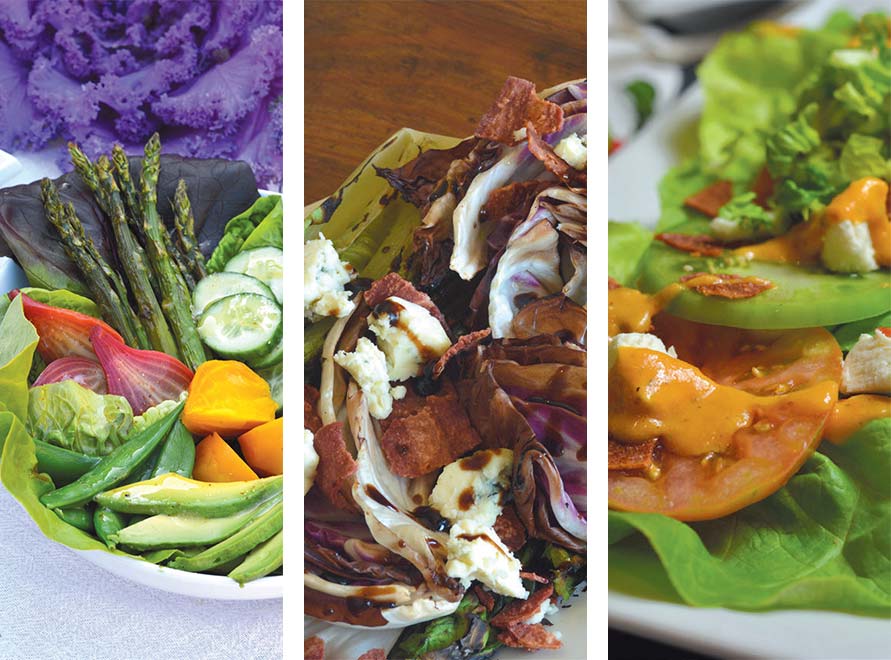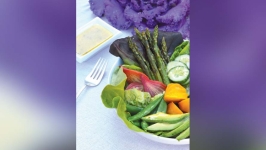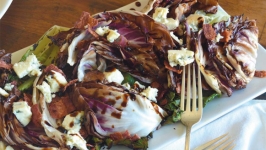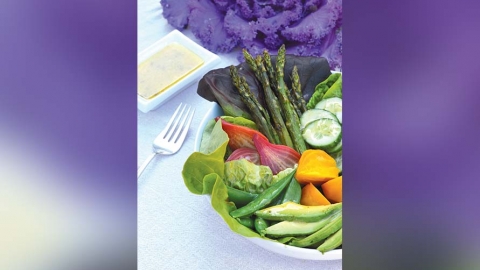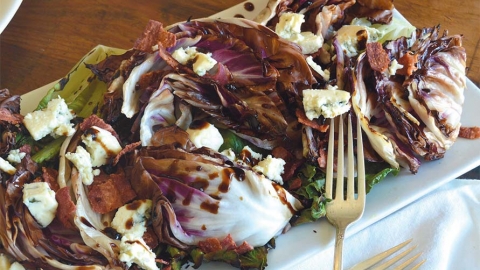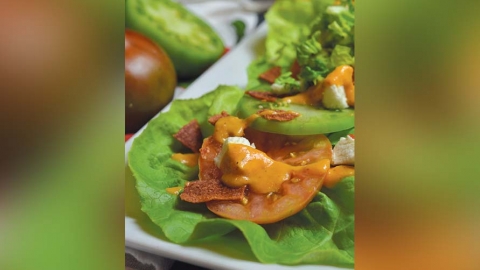Just the Tip of the Iceberg when it comes to Lettuce
Lettuce is not thought of as an innovative ingredient. And even though the wedge salad has experienced a bit of a renaissance lately with the addition of artisan-crafted bleu cheese and candied bacon, lettuce isn’t the first item on a shopping list for a special dinner. But that wedge of lettuce is just the tip of the iceberg when it comes to lettuce selection, pardon the pun. Spring is the perfect time of year to bone up on lettuce varieties and the dressings that bring them to life.
GET TO KNOW YOUR GREENS
Lettuce is typically one of the season’s first plantings as most lettuces enjoy cooler weather to thrive. Smart home gardeners typically spread their plantings out so those tender greens can be enjoyed throughout the spring and summer season. Come late fall, the next lettuce plantings can generate some last bowls of lettuce until the colder weather moves in. There are over 100 varieties of lettuce. However, there are only four common types of lettuce -- butterhead, iceberg, loose leaf and romaine.
Butterheads – The most well-known butterhead lettuces are Boston and Bibb. These lettuces are prized for their buttery leaves that are formed into a loose head. Flavors tend to be on the mild side. Butterhead lettuces are sometimes sold with their roots intact. This type of harvesting keeps the lettuce fresher and is a great choice if you only need a few tender leaves.
Loose leaf lettuce – Found in colors from light green to deep red, loose leaf lettuce consists of packed leaves that are joined by a stem. With a slightly crisper leaf than butterhead yet still having a soft flavor, loose leaf lettuces are a great all-around lettuce pick. If you aren’t using the entire head, try picking just the leaves that you need, keeping the rest of the leaves attached to the stem.
Iceberg lettuce – Iceberg is the lettuce we all grew up with. It also seems to be the lettuce that gets a bad rap. Although its familiar pale green cabbage-like head is most often thought of as the lettuce of salad bars and wedge salads, it is still nutrient-rich. Iceberg lettuce contains smaller amounts of nutrients than its leafy counterparts, but is still a good source of calcium, fiber, iron, potassium and vitamins A and C.
Romaine lettuce – With its sturdy leaf and loaf-shaped head, romaine lettuce is known for a crisp texture and a stronger taste. No Caesar dressing would be the same without a resting place on a bowlful of crisp romaine.
LETTUCE’S OTHER RELATIVE
Chicories are a close relative to the lettuce family. The bold and sometimes bitter flavors of chicories create a perfect counterbalance to a mix of softer lettuces like limestone and little gems. These more robust salad greens are easy to find at most grocery stores and farmers markets. Get to know a few of them before you go on a chicory hunt.
Belgian endive - You may be more familiar with the long pale leaves of Belgian endive as a resting place for a favorite dip or appetizer spread. These compact chicories are approximately 3 to 4 inches in length and grow almost entirely undergrown without sunlight. This helps develop endive’s sweet yet slightly bitter flavor and preserve its signature ivory hue.
Radicchio - This crunchy green is not actually green. Radicchio is small in size (about 4 to 5-inches round) and is red or slightly purple in color. It’s terrific as a raw addition to a salad, but really shines when it is lightly brushed with olive oil and tossed on a hot grill. The natural sweetness of the radicchio is brought out by the heat.
Frisée - Frisée is easy to pick out in a crowd. Like its name suggests, frisée leaves are, well, frizzy. Adding a bit of frisée to a bowl of spring greens provides some great texture and height to a salad.
SPRING DRESSINGS
Now that you have a handle on some of the types of lettuces available, it’s time to gussy those greens up and get them properly dressed for their spring showing.
Add some other spring vegetable friends to your salad mix. Spring is the time to enjoy colorful baby beets, crisp snap peas and some of those early asparagus spears. And don’t forget to include radishes. One of the easiest spring crops to plant, radishes come in all sizes and colors. One of my favorites is the watermelon radish. With its pale green skin and bright pink flesh, it's the perfect radish to highlight a spring salad.
For a dressing, try a simple vinaigrette made with a splash of lemon, a swirl of Dijon mustard and a healthy dose of extra-virgin olive oil. Dijon mustard is a natural emulsifier. What’s an emulsifier? An ingredient that helps two things that don’t like to go together create a perfect harmony. Oil and vinegar tend to separate when blended. A bit of mustard not only provides great flavor, it also helps blend the two ingredients together.
ROAST FOR MORE FLAVOR
The use of tomatoes shouldn’t be limited to a simple salad garnish. Tomatoes also make a great flavor addition to a vinaigrette.
Start by quartering a few tomatoes and shallots. A quick toss in olive oil and a visit to a high heat oven, and the mixture is ready to visit a blender or food processor. Add a drizzle of honey or agave nectar to offset the acidity of the tomato, a pinch of smoked paprika for extra flavor and some extra-virgin olive oil, and your roasted tomato vinaigrette is table ready.
Try this dressing on a salad made with leafy tender lettuce like black seeded simpson or lollo rossa along with thinly sliced heirloom tomatoes. Sprinkle with some crispy bacon and you have a perfect BLT salad.
GO BOLD WITH BALSAMIC
Balsamic vinegars, with their aged bold flavors, make a richly flavored dressing. Adding a bit of maple syrup to the dressing adds a pop of sweetness. Herbs are not a traditional addition to a balsamic dressing, but the bold flavor of balsamic holds up well to heartier herbs like thyme and rosemary. Try mixing the balsamic vinaigrette ingredients in a high-speed blender to create a creamier vinaigrette. Add some of the fresh herbs prior to blending, saving a couple of teaspoons of the chopped herbs to blend in at the end.
The maple balsamic herb dressing is perfect as a topping for a salad of grilled radicchio and Belgian endive. When grilling these chicories, make sure to keep their stems intact so the delicate leaves stay together. The maple balsamic vinaigrette provides a great finish to the salad along with a sprinkling of a bold cheese like your favorite blue or Montrachet.


